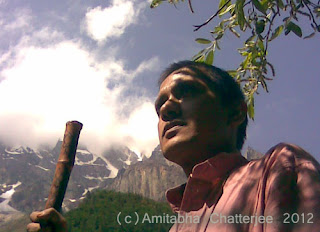The principle of Khechari was adopted by the Yogis from snakes going in
hibernation for long periods of time. They improved upon it and came up
with Khechari mudra. Such is my personal belief. Khechari means Kha=sky, Charam=to travel. It doesn't imply that the yogi will rise up from his seat and begin to fly with this Mudra. It means that the Tongue reaches up towards the sky. Yogiraj Gorakhnath has described about an inverted well and a Cave of Buzzing black bees. I think he was talking about the tongue rising up through the secret passage towards the third eye; finally the yogi's consciousness reaches a center where the Para Naad OM is constantly reverberating on its own; that's the Bhramar Guha (Cave of black bees).
A detailed description of the process of Khechari Mudra is given in Hatha Yoga Pradipika chapter 3. This magnificent book was written by Swami Svatmarama, under the direction of his Guru, Yogiraj Gorakhnath. Svatmarama mentions his lineage as, Adinath Shiva to Matsyendra Nath to Goraksha Nath to himself.
Hathayoga Pradipika, 3rd Chapter:
Verse 32: Kechari Mudra is done by inserting the tongue into the hole in the soft palate at the roof of the mouth, by turning it backward.
33. In order to be successful, the tongue must lengthened into a Lambika (such as the long tongue of Goddess Kali). Sometimes cutting the frenulum (the mucus membrane that holds back the underside of the tongue to the floor of the mouth) is necessary. Else, pull or move your tongue around constantly. When it gets long enough, to reach the point between the eyebrows, then Kechari becomes possible.
36. The frenulum is cut 1/2 millimeter each day and the wound is sealed. In 6 months, the tongue becomes free & quite long. (Note: Dont eat food or drink that are too hot like chilli or too sour. This will make the tongue thicker and interfere with Khechari.)
38. A Yogi adept in Khechari, who turns his tongue upward in his seat (usually Siddhasana), is impervious to poisons, disease, ageing and death.
39. He overcomes disease, death, sleep, laziness, hunger, thirst, and fainting.
43. NECTAR: If a Yogi can drink the Juice of Soma (Moon) by meditating in Khechari mudra, surely he subdues Death within 15 days!
44. The Khechari expert cannot be killed even if bitten by the most poisonous snake; because his body is imbued with nectar.
45. Death cannot enter a body which is full of Nectar secreted from Soma (The triangular Moon mandala inside Sahasrara, the 1000 petalled Lotus)
48. The Juice of Immortality is secreted by the moon.
49. Taste the nectar with the tip of the tongue. The Ambrosia may be salty, bitter, sour, milky, or, like ghee(clarified butter) or, honey. Be free from disease, old age, be thou immortal and pull astral beings by the magnetic force.
50. The nectar falls from the Moon in the brain to the 8 petalled lotus near the heart. He who catches it by balancing Prana and doing Khechari and meditates on the source of all Power (Kundalini or Mahashakti or Almighty or whatever you call it!) becomes free from all physical ailments and lives a very long life.
Note: If you try it unguided (without the help of an experienced yogi) and block the internal nares and stop the oxygen flow, you may be unconscious or even suffer terminal damage. Please be patient, this is not a magic pill, it may take years to accomplish. A surgeon might assist you in getting the frenulum of tongue cut. But even then you must practice everyday by turning the tongue back, pushing the top palate, etc.
I didn't cut my frenulum gradually for six months! Rather, I got it cut in one day, by a surgeon. The post operative exercise made it possible to grow longer. I had pain from the wound, that lasted 3 weeks.
Here the Juice from the forehead that the yogi drinks is referred to as Soma Rasa, which literally means, Lunar Juice. The source of this nectar is the triangular seat of the Moon in the forehead Chakra. Also note that the Rishis of yore used to offer Soma Rasa to the gods in their yajnas (fire-rituals), as mentioned in the Vedas. What was an external ritual for the Vedic sages, has been turned into an internal reality by yogis like Gorakhnath.
Yogi Gorakhnath said that yoga without knowledge and knowledge
without yoga are both useless... like a bird with a single wing. It
cannot fly like that. So, you must combine spiritual wisdom, meditation
on one higher power with your physical yoga in order to make it a
success. Otherwise, you will only gain a blackout state like a long deep
sleep out of Khechari. Yoga, after all, is not just a gymnastic
exercise, its practical spirituality.
Good luck.
Good luck.
~ written by:
Amitabha Chatterjee
Amitabha Chatterjee
You can also see this article in my other site here.

























